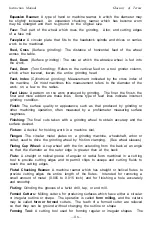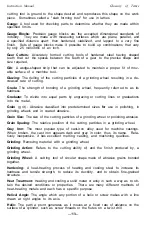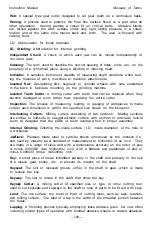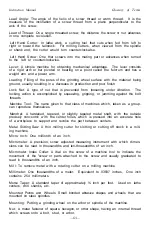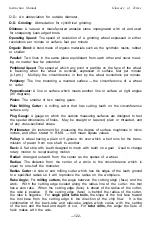
Instruction Manual Glossary of Terms
O.D.: An abbreviation for outside diameter.
O.D. Grinding:
Abbreviation for cylindrical grinding.
Oilstone:
A natural or manufactured abrasive stone impregnated with oil and used
for sharpening keen edged tools.
Operating Speed:
The speed of revolution of a grinding wheel expressed in either
revolutions per minute or surface feet per minute
Organic Bond:
A bond made of organic materials such as the synthetic resins, rubber
or shellac.
Parallel:
Two lines in the same plane equidistant from each other and never meet
ing no matter how far extended
Peripheral Speed:
The speed at which any point or particle on the face of the wheel
is traveling when the wheel is revolved, expressed in surface feet per minute
(s.f.p.m.) Multiply the circumference in feet by the wheel revolutions per minute.
Periphery:
The line bounding a rounded surface — the circumference of a wheel
or cutter.
Perpendicular:
A line or surface which meets another line or surface at right angles
(90 degrees).
Pinion:
The smaller of two mating gears.
Plain Milling Cutter:
A milling cutter that has cutting teeth on the circumference
surface only
Plug Gauge:
A gauge on which the outside measuring surfaces are designed to test
the special dimensions of holes. May be straight or tapered, plain or threaded, and
of any cross-sectional shape.
Profilometer:
An instrument for measuring the degree of surface roughness in micro
inches, and often stated in R.M.S. — root mean square values.
Pulley:
A wheel having a plain
or
V-groove rim over which a belt runs for the trans
mission of power from one shaft to another.
Rack:
A flat strip with teeth designed to mesh with teeth on a gear Used to change
rotary motion to reciprocating motion
Radial:
Arranged outward from the center as the spokes of a wheel
Radius:
The distance from the center of a circle to the circumference which is
equal to one-half the diameter.
Radius Cutter:
A side or end milling cutter which has the edges of the teeth ground
to a specified radius so it will reproduce the radius on the workpiece.
Rake Angle:
For
milling cutters,
the angle between the cutting edge (face) and the
work. With the cutting edge located along the radius line of the cutter, the tool
has a zero rake. When the cutting edge (face) is ahead of the radius of the cutter,
the rake is positive. If the cutting edge (face) is behind the radius of the cutter,
the rake is negative. For
single point lathe tools,
the slope of the tool face toward
the tool base from the cutting edge in the direction of the chip flow. It is the
combination of the back-rake and side-rake angles which varies with the setting
of the tool and the feed and depth of cut. For
twist drills,
the angle the flute or
helix makes with the axis.
—122-











